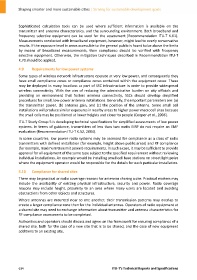Page 624 - Shaping smarter and more sustainable cities - Striving for sustainable development goals
P. 624
Sophisticated calculation tools can be used where sufficient information is available on the
transmitter and antenna characteristics, and the surrounding environment. Both broadband and
frequency selective equipment can be used for the assessment (Recommendation ITU‐T K.61).
Measurements conducted with broadband equipment, however, might lead to overly conservative
results. If the exposure level in areas accessible to the general public is found to be above the limits
by means of broadband measurements, then compliance should be verified with frequency
selective equipment. Otherwise, the mitigation techniques described in Recommendation ITU‐T
K.70 should be applied.
4.9 Requirements for low power systems
Some types of wireless network infrastructure operate at very low power, and consequently they
have small compliance zones or compliance zones contained within the equipment cover. These
may be deployed in many locations as part of SSC infrastructure in order to provide widespread
wireless connectivity. With the aim of reducing the administrative burden on city officials and
providing an environment that fosters wireless connectivity, SSCs should develop simplified
procedures for small, low‐power antenna installations. Generally, the important parameters are: (a)
the transmitter power, (b) antenna gain, and (c) the position of the antenna. Some small cell
installations will produce similar exposures in nearby areas to higher power macrocell sites because
the small cells may be positioned at lower heights and closer to people (Cooper et al., 2006).
ITU‐T Study Group 5 is developing technical specifications for simplified assessments of low power
systems. In terms of guidance, transmitters of less than two watts EIRP do not require an EMF
evaluation (Recommendation ITU‐T K.52, 2004).
In some countries, low power radio systems may be assessed for compliance as a class of radio
transmitters with defined installation (for example, height above public areas) and RF compliance
(for example, maximum transmit power) requirements. In such a case, it may be sufficient to provide
approval for all equipment of the same type subject to the specified requirement without reviewing
individual installations. An example would be installing small cell base stations on street light poles
where the equipment operator would be responsible for the details for each particular installation.
4.10 Compliance for shared sites
There may be practical or radio coverage reasons for antennas sharing a site. Practical matters may
include the availability of existing physical infrastructure, security and power. Radio coverage
reasons may include height, proximity to an area where many users are located and avoiding
obstructions from other objects and structures.
Where antennas are mounted near to one another, their transmission patterns may overlap to
create a larger compliance zone than for the individual antennas. Operators of radio equipment at
a shared site may need to exchange information about transmitter and antenna characteristics for
RF compliance assessments to be completed.
Authorities and operators should discuss and agree on the framework for ensuring compliance of a
shared site, both for the case of a new site that is to be shared, and the case of new equipment
additions to an existing site.
614 ITU‐T's Technical Reports and Specifications

